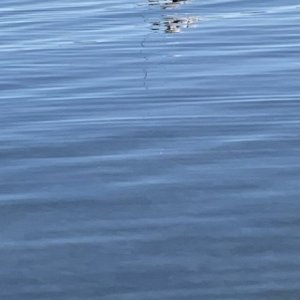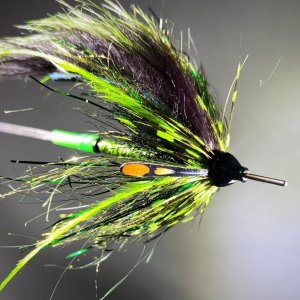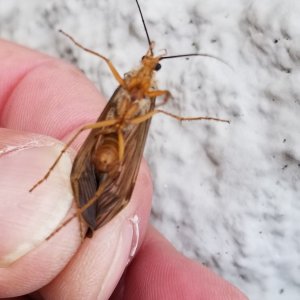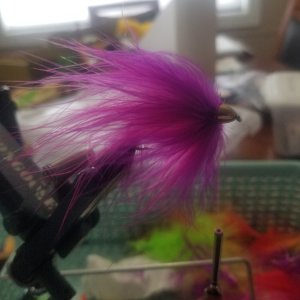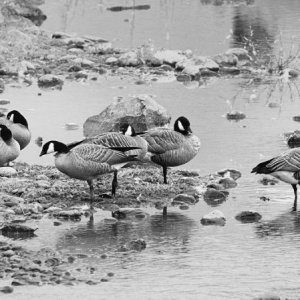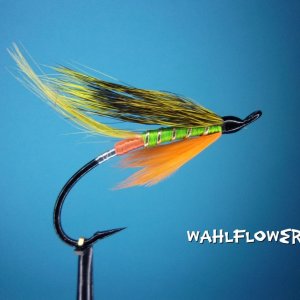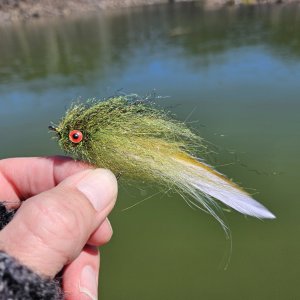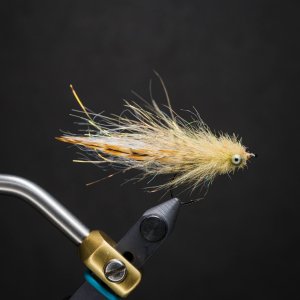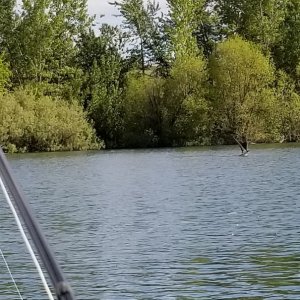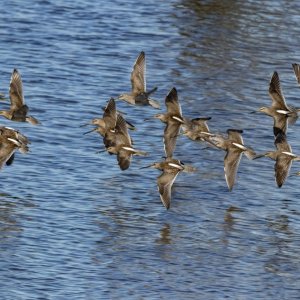My daughter checked out a book on salmon from her library, and of course the topic turned to dams and fish ladders. It got me thinking about dams without passage and if there is also the possibility of residualized salmon "seeding" a resurgence after a dam removal a la steelhead on the Elwha? In OR and WA I have caught micro-jack (8-12") sized chinook and coho, some still with parr marks. All of those rivers still have an ocean going spawning component though. Can residualized salmon smolts spawn with other residualized smolts? Or do they still need the bigger ocean returners to keep a population?
You are using an out of date browser. It may not display this or other websites correctly.
You should upgrade or use an alternative browser.
You should upgrade or use an alternative browser.
Another biology question, residualized/landlocked Pacific salmon spawning?
- Thread starter DerekWhipple
- Start date
The short answer is yes. We have to look no further than the great lakes where Chinook, coho and pinks have established themselves. Here in the PNW there are a number of reservoirs where sockeye have established a completely freshwater population via the kokanee live history. There are also a few larger lakes/reservoirs where Chinook have established self sustaining populations though usually at low levels.
There some western Washington lakes with anadromous access where some coho fry/smolt revisualize and reach maturity though I'm sure they would maintain a population without the infusion of juveniles from the anadromous population. Not aware of any examples from chum salmon though given the tendency of our salmon to surprise us I would assume that it is impossible.
Curt
There some western Washington lakes with anadromous access where some coho fry/smolt revisualize and reach maturity though I'm sure they would maintain a population without the infusion of juveniles from the anadromous population. Not aware of any examples from chum salmon though given the tendency of our salmon to surprise us I would assume that it is impossible.
Curt
Green Peter Reservoir in Oregon has a small population of landlocked chinook, I think there are a couple of articles with pictures if you look it up. Recently the Army Corp started putting a lot of adult salmon into it though to supplement that population and study fish passage through the dam so presumably the fish that were already there weren't enough.My daughter checked out a book on salmon from her library, and of course the topic turned to dams and fish ladders. It got me thinking about dams without passage and if there is also the possibility of residualized salmon "seeding" a resurgence after a dam removal a la steelhead on the Elwha? In OR and WA I have caught micro-jack (8-12") sized chinook and coho, some still with parr marks. All of those rivers still have an ocean going spawning component though. Can residualized salmon smolts spawn with other residualized smolts? Or do they still need the bigger ocean returners to keep a population?
For what it's worth I also fished one of Green Peters tributaries while the salmon were spawning after they released them and didn't see a single wild fish out of a couple hundred that were spawning along the stretch I walked.
Pink Nighty
Life of the Party
It's my understanding that no salmon species have an imperative to enter salt water, at least in terms of reaching sexual maturity. I have seen research that has 2-3% of Male chinook never leaving certain systems, and spawning at trout sizes. Fish kept for broodstock are sometimes captured as fry and raised in freshwater until they are ready to spawn.
However because of the mass spawning nature of salmon, as well as them dying after the fact, the overwhelming majority of those fish will vacate their natal streams in search of increases caloric opportunity.
However because of the mass spawning nature of salmon, as well as them dying after the fact, the overwhelming majority of those fish will vacate their natal streams in search of increases caloric opportunity.
Every once in a while I get something different in our rivers. I talked to the WDFW biologist and was told that a small percentage of the chinook, especially males, will residualize.
This is an interesting question. I found out when learning about origins of Tenkara, that many (extremely high gradient) mountain stream drainages in Japan have always had natural barriers to saltwater, and more recently manmade barriers for small hydropower and flood control. For hundreds of years the mountain villages relied on fish in their local stream reaches for sustenance and expert, professional fishermen-hunters in the villages made a living providing them.
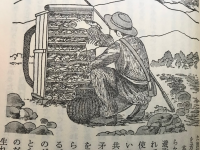
To maintain that source of protein under this kind of catch & kill pressure ^^^ they were transporting two sub-species of anadromous red-spotted masu salmon called Amago and Yamame, and whitespotted char called Iwana, from lower elevations above the barriers for many-many years (perhaps hundreds of years?). Long 1-piece whole cane (not split) fixed-line rods with braided horsehair lines to cast hand-tied (without a vise) flies were the ideal way to catch these fish and kept stashed in strategic locations along these extremely rugged mountainous stream reaches.
When Tenkara fixed-line fishing began to become known outside of the mountain regions and a gained a following amongst "leisure" sport fishermen in the 1960s the big Japanese fishing tackle companies (Daiwa, Shimano...) and family-run shops began producing fiberglass, and later graphite, Tenkara rods. Because the fish were being harvested for food the fish weren't maturing so a 12" fish was considered a trophy. As a result the commercially built rods were designed for small fish and light nylon (later fluorocarbon) braided (later mono or "level") casting line and very light tippets. Now, with a migration of people from the mountainous regions to lower elevations combined with the remoteness of these areas and the extremely steep and rugged terrain removing the fishing pressure, along with acceptance of C&R by sport anglers in these streams, I am frequently seeing videos on this husband & wife team's Tenkara fishing - bushcraft YT channel with landlocked salmon and char like these being caught at elevations of 1000 - 2000 meters (and higher?). They make me wish I'd discovered this 40+ years ago.
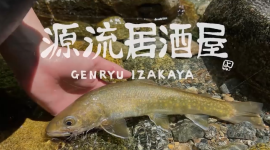
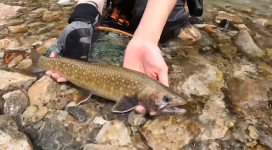
I don't speak or read Japanese, and there are no English subtitles but I'm fan.
https://www.youtube.com/@genryuizakaya
(translation: genryu - headwaters izakaya - pub)

To maintain that source of protein under this kind of catch & kill pressure ^^^ they were transporting two sub-species of anadromous red-spotted masu salmon called Amago and Yamame, and whitespotted char called Iwana, from lower elevations above the barriers for many-many years (perhaps hundreds of years?). Long 1-piece whole cane (not split) fixed-line rods with braided horsehair lines to cast hand-tied (without a vise) flies were the ideal way to catch these fish and kept stashed in strategic locations along these extremely rugged mountainous stream reaches.
When Tenkara fixed-line fishing began to become known outside of the mountain regions and a gained a following amongst "leisure" sport fishermen in the 1960s the big Japanese fishing tackle companies (Daiwa, Shimano...) and family-run shops began producing fiberglass, and later graphite, Tenkara rods. Because the fish were being harvested for food the fish weren't maturing so a 12" fish was considered a trophy. As a result the commercially built rods were designed for small fish and light nylon (later fluorocarbon) braided (later mono or "level") casting line and very light tippets. Now, with a migration of people from the mountainous regions to lower elevations combined with the remoteness of these areas and the extremely steep and rugged terrain removing the fishing pressure, along with acceptance of C&R by sport anglers in these streams, I am frequently seeing videos on this husband & wife team's Tenkara fishing - bushcraft YT channel with landlocked salmon and char like these being caught at elevations of 1000 - 2000 meters (and higher?). They make me wish I'd discovered this 40+ years ago.


I don't speak or read Japanese, and there are no English subtitles but I'm fan.
https://www.youtube.com/@genryuizakaya
(translation: genryu - headwaters izakaya - pub)
Last edited:
We caught a few chinook in a lake back in the 60’s while fishing for cutts and Kokanee.
The dam that formed the lake was built in the 20’s, so 40 years after the damn went in there were still some present. I’m not sure if there are any left today after 100 years of being landlocked.
SF
The dam that formed the lake was built in the 20’s, so 40 years after the damn went in there were still some present. I’m not sure if there are any left today after 100 years of being landlocked.
SF
This topic is pretty interesting to me.
I remember when I lived on the Palouse and went down to see the fish ladder on the Snake, there would be Chinook no bigger than 10-12 inches, but looked mature enough to spawn with the dark coloration and everything. I thought that there was no way those fish would migrate all the way out to the Pacific if they came back at that size.
I've also heard of a few Westside lakes with outlets to spawning steams (like Lake Stevens or Cottage Lake in Woodinville for example) have a few fish that end up never migrating out and somehow end up in the lake.
I remember when I lived on the Palouse and went down to see the fish ladder on the Snake, there would be Chinook no bigger than 10-12 inches, but looked mature enough to spawn with the dark coloration and everything. I thought that there was no way those fish would migrate all the way out to the Pacific if they came back at that size.
I've also heard of a few Westside lakes with outlets to spawning steams (like Lake Stevens or Cottage Lake in Woodinville for example) have a few fish that end up never migrating out and somehow end up in the lake.
Here's a few links to articles on various chinook life history strategies. I recall first hearing about parr spawning with adult fall chinook in the Shasta River (tributary to the Klamath) back in the early 2000's. The guy that first described this in the Shasta also identified 7 distinct life histories for rainbow trout in the same watershed which is fascinating to me.

 californiawaterblog.com
californiawaterblog.com
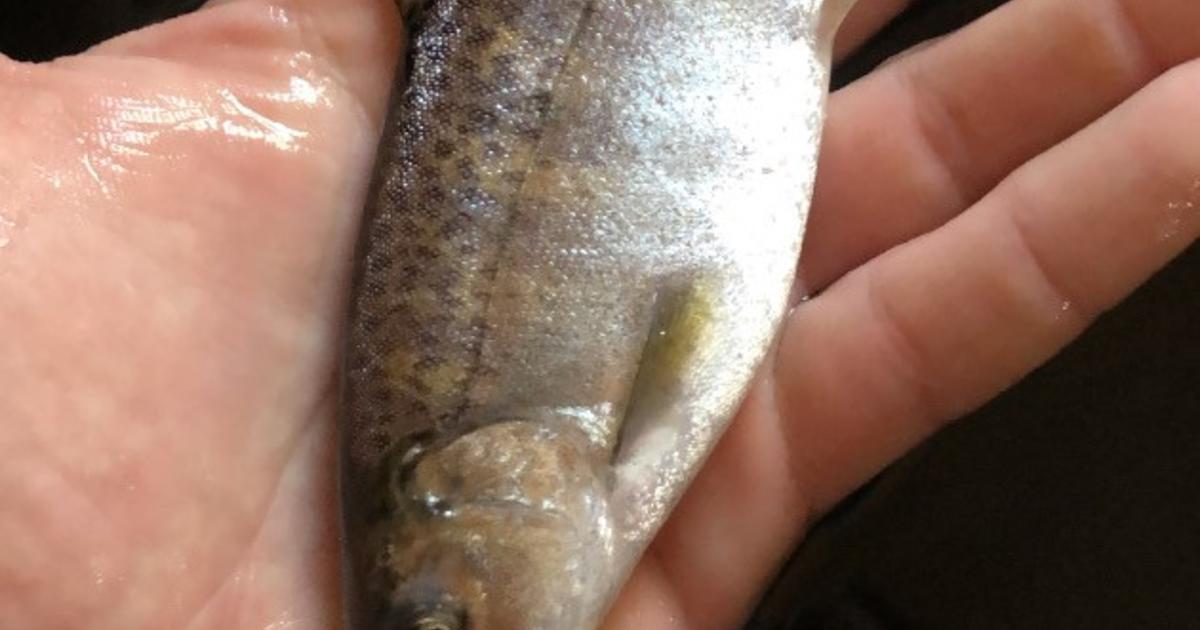
 idfg.idaho.gov
idfg.idaho.gov

Sex, lies and videotape: Premature maturation of Chinook salmon on Shasta River
Carson Jeffres, Senior Research Associate, Center for Watershed Sciences, University of California – Davis Migration to and from the sea (anadromy) is the iconic pattern we associate with Pacific s…
 californiawaterblog.com
californiawaterblog.com

Sneaker males: Not all male Chinook have the same life history and spawning habits
Chinook salmon have complicated and highly variable life histories driven by environmental factors, growth and genetics. Normally, these fish spend several years foraging in the Pacific Ocean before returning as adults to their natal freshwater streams to spawn. However, sometimes nature has...
We caught a few chinook in a lake back in the 60’s while fishing for cutts and Kokanee.
The dam that formed the lake was built in the 20’s, so 40 years after the damn went in there were still some present. I’m not sure if there are any left today after 100 years of being landlocked.
SF
This is kind of what I'm getting at. Are there chinook and coho still present in drainages above impassable dams that have been given up on by DFW for salmon? An "extinct" strain gene bank.
Apparently, early maturing/not out-migrating fish are a bigger problem among hatchery fish, so add that to the list of hatchery's effects on fish.
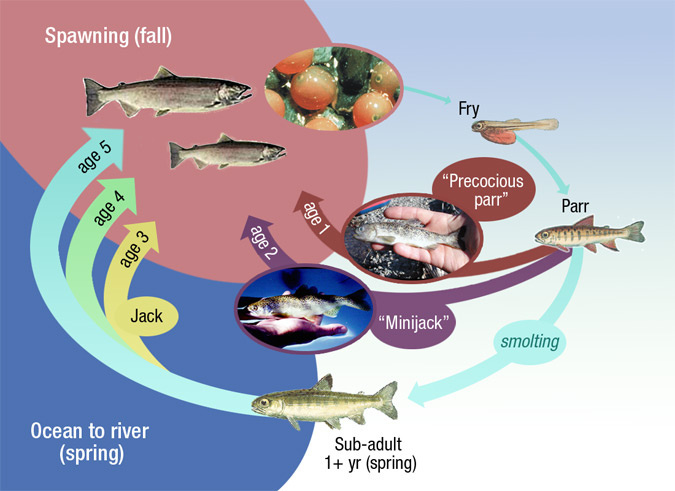
 www.fisheries.noaa.gov
www.fisheries.noaa.gov

The Tale of the Migrating Mini-Jack
Physiologists Don Larsen and his colleagues are studying the physiology of the “mini-jack” to determine how hatcheries might be contributing to high rates of early maturation in male salmon.
Uncle Stu
Steelhead
"His group has found that migrating mini-jacks are occurring at rates 10-20 times higher than observed in wild populations. An average of 40% of the male hatchery fish never migrate to the ocean, but rather mature early as mini-jacks."
This subject has always fascinated me. We used to fish a hatchery run in SE AK where the jack coho were so numerous and aggressive that we often caught more jacks than adults. Our custom was to freeze the adults and BBQ the jacks daily... they are thick and delicious.
This subject has always fascinated me. We used to fish a hatchery run in SE AK where the jack coho were so numerous and aggressive that we often caught more jacks than adults. Our custom was to freeze the adults and BBQ the jacks daily... they are thick and delicious.
I just read Green Peter (along with 3 other willamette basin dams) is going to be drawn down this summer to support salmon passage through the bottom of the dam. The "locals" are upset...Green Peter Reservoir in Oregon has a small population of landlocked chinook, I think there are a couple of articles with pictures if you look it up. Recently the Army Corp started putting a lot of adult salmon into it though to supplement that population and study fish passage through the dam so presumably the fish that were already there weren't enough.
For what it's worth I also fished one of Green Peters tributaries while the salmon were spawning after they released them and didn't see a single wild fish out of a couple hundred that were spawning along the stretch I walked.
They have done the same to Fall creek here in the upper Willamette for a few years now. Some people are rubbed the wrong way, I am for anadromous fish.I just read Green Peter (along with 3 other willamette basin dams) is going to be drawn down this summer to support salmon passage through the bottom of the dam. The "locals" are upset...

